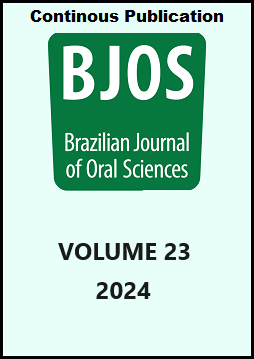Abstract
Aim: Like other fields of health, the main focus in dentistry has shifted from treatment to prevention of diseases. Parents have a vital role in deciding about their children’s oral health issues. This study aims to investigate the effectiveness of four educational methods (including printed pamphlets, digital pamphlets, faceto-face education, and educational films) in increasing the awareness of parents about preventive orthodontic treatments. Methods: The study samples were selected from patients who were referred to the Pediatric Dentistry Department. 150 parents of children between 4-12 years old participated in the study. They filled out a questionnaire including demographic data and knowledge about orthodontic problems and their early treatments. Then they were divided into five groups (control, printed pamphlet, digital pamphlet, face-to-face, educational films) and after one month they repeated the test. Results: A total of 102 fathers and 48 mothers were evaluated. There was no statistical difference between different ages, sex, or income in terms of their awareness, but the awareness score between educational groups was different. There has been observed a significant increase in the awareness level of all four groups (except the control group) (P < 0.05). The highest score was seen in the video group. The difference between printed pamphlets and digital pamphlets was not significant. Conclusions: The results indicate that educational films are the most effective way of increasing awareness about preventive orthodontic treatments.
References
Doğan AA, Sari E, Uskun E, Sağlam AM. Comparison of orthodontic treatment need by professionals and parents with different socio-demographic characteristics. Eur J Orthod. 2010 Dec;32(6):672-6. doi: 10.1093/ejo/cjp161.
Dhar V, Jain A, Van Dyke TE, Kohli A. Prevalence of gingival diseases, malocclusion and fluorosis in school-going children of rural areas in Udaipur district. J Indian Soc Pedod Prev Dent. 2007 Apr-Jun;25(2):103-5. doi: 10.4103/0970-4388.33458.
Bhullar MK, Nirola A. Malocclusion Pattern In Orthodontic Patients. Indian J Dent Sci. 2012 Oct;4(Suppl 1) 20-22.
Al-Sarheed M, Bedi R, Hunt NP. The views and attitudes of parents of children with a sensory impairment towards orthodontic care. Eur J Orthod. 2004 Feb;26(1):87-91. doi: 10.1093/ejo/26.1.87.
Bakdash MB. Patient motivation and education: a conceptual model. Clin Prev Dent. 1979 Mar-Apr;1(2):10-4.
Scholle RH. The final barrier. J Am Dent Assoc. 1980 Oct;101(4):740. doi: 10.14219/jada.archive.1980.0387.
Bahreman A. Early-age orthodontic treatment, introduction. New York: Quintessence; 2013. p.13-15.
Wong ML, Che Fatimah Awang, Ng LK, Norlian D, Rashidah Dato Burhanudin, Gere MJ. Role of interceptive orthodontics in early mixed dentition. Singapore Dent J. 2004 Dec;26(1):10-4.
Bekker HL, Luther F, Buchanan H. Developments in making patients' orthodontic choices better. J Orthod. 2010 Sep;37(3):217-24. doi: 10.1179/14653121043119.
Hirst L. Awareness and knowledge of orthodontics. Br Dent J. 1990 Jun 23;168(12):485-6. doi: 10.1038/sj.bdj.4807247.
Taherdoost H. Validity and reliability of the research instrument; how to test the validation of a questionnaire/survey in a research. Int J Acad Res Manag. 2016;5(3):28-36. doi: 10.2139/ssrn.3205040.
McKight PE, Najab J. Kruskal-wallis test. The Corsini encyclopedia of psychology. 2010:1:1-10. doi: 10.1002/9780470479216.corpsy0491.
Gerald B. A brief review of independent, dependent and one sample t-test. Int J Appl Mathemat Theoret Phys. 2018;4(2): 50-4. doi: 10.11648/j.ijamtp.20180402.13
Barrieshi-Nusair K, Alomari Q, Said K. Dental health attitudes and behaviour among dental students in Jordan. Community Dent Health. 2006 Sep;23(3):147-51.
Naretto S. Principles in contemporary orthodontics. London: IntechOpen; 2011. p.251-7.
Jain M. Dhakar N. Timing of orthodontic treatment, J Orthod Res. 2013;1(3): 99-102. doi: 10.4103/2321-3825.123320.
Nagarajan S, Pushpanjali K. The relationship of malocclusion as assessed by the Dental Aesthetic Index (DAI) with perceptions of aesthetics, function, speech and treatment needs among 14- to 15-year-old schoolchildren of Bangalore, India. Oral Health Prev Dent. 2010;8(3):221-8.
Milen A, Tala H, Hausen H, Heinonen OP. Dental health status, habits and care of Finnish children and youths in 1981–82. A feasibility study of an information system. Finland, Helsinki: Health Services Research by the National Board of Health; 1986. N.39.
Patel JH, Moles DR, Cunningham SJ. Factors affecting information retention in orthodontic patients. Am J Orthod Dentofacial Orthop. 2008 Apr;133(4 Suppl):S61-7. doi: 10.1016/j.ajodo.2007.07.019
Rud B, Kisling E. The influence of mental development on children's acceptance of dental treatment. Scand J Dent Res. 1973;81(5):343-52. doi: 10.1111/j.1600-0722.1973.tb00337.x.
Chhabra N, Chhabra A. Parental knowledge, attitudes and cultural beliefs regarding oral health and dental care of preschool children in an Indian population: a quantitative study. Eur Arch Paediatr Dent. 2012 Apr;13(2):76-82. doi: 10.1007/BF03262848.
Deepika P, Suma S, Chand P, Prinka S. Parental awareness about malocclusion in their children: a common yet unknown disorder. J Dent Med Sci. 2018;17(2):34-7.
Oshagh M, Danaei SM, Ghahremani Y, Pajuhi N, Boushehri SG. Impact of an educational leaflet on parents' knowledge and awareness of children's orthodontic problems in Shiraz. East Mediterr Health J. 2011 Feb;17(2):121-5.
Çapan BŞ. YouTube as a source of information on space maintainers for parents and patients. PLoS One. 2021 Feb;16(2):e0246431. doi: 10.1371/journal.pone.0246431.
Al-Jobair A, Al-Emran SE. Attitudes of Saudi Arabian mothers towards the digit-sucking habit in children. Int J Paediatr Dent. 2004 Sep;14(5):347-54. doi: 10.1111/j.1365-263X.2004.00567.x.
Harwood A, Harrison JE. How readable are orthodontic patient information leaflets? J Orthod. 2004 Sep;31(3):210-9; discussion 201. doi: 10.1179/146531204225022425.

This work is licensed under a Creative Commons Attribution 4.0 International License.
Copyright (c) 2024 Amin Jahanbin, Monireh Haghifar, Mohamadreza Shahamfar


